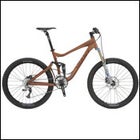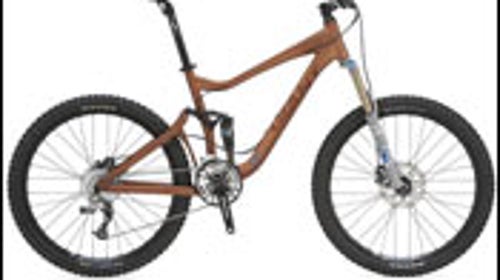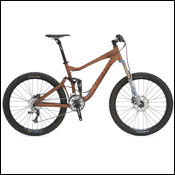Dual-suspension bikes have pretty much taken over the market. But hardtails still really have a place.
Giant Reign 1 Mountain Bike
 Reign 1 Mountain Bike
Reign 1 Mountain BikeDualies, of course, offer the benefit of a softer ride. They also bounce around less on rough terrain, and that can mean your back tire is more apt to retain contact during hard cornering or over bumpy stuff. My everyday dualie is a Marin Mount Vision Pro ($4,545; marinbikes.com) that IÂ’ve had for two years or so. I had some doubts about the extra complexity of the rear suspension, but all of that has been trouble-free.
Other very good dual-suspension bikes include GiantÂ’s Reign 1 ($2,400; giant-bicycles.com) and REIÂ’s house-brand Novara Method 1.0 ($1,600; rei.com). Both have a good component set in a moderate price range and use up-to-date geometry that eliminates much of the mechanical inefficiency for which dualies long were known. If you have the dough, look into Santa CruzÂ’s Blur XC XTR ($4,600; santacruzmtb.com), a super-fast, light dual-suspension bike that is generally seen as the pinnacle of the type.
That said, itÂ’s true that dual-suspension bikes weigh more than hardtails, all things being equal. And even the best dualies still sap a little pedal energy with some bobbing in the rear. So, quite a few pros still ride hardtails. TrekÂ’s 8000 ($1,800; trekbikes.com) is an excellent hardtail, with a RockShox Reba SL fork, stiff and light aluminum frame, and a usable mix of Shimano LX and XT components.
One intriguing option is to go with a hardtail and 29-inch wheels. The idea is that the bigger wheel has a lower angle of attack when it hits a log or rock, so it rolls over more easily than standard 26-inch wheels. My engineer friend Paul insists the difference between 26 and 29 inches isnÂ’t that great, but most people I know who have ridden 29ers like them very much. The wheels are a bit heavier, of course, and a bike equipped with them isnÂ’t quite as agile on a twisty trail. But, try a Jamis Dakota 29 ($1,200; jamisbikes.com).
The 2008 Winter şÚÁĎłÔąĎÍř BuyerÂ’s Guide is now online. From snow sports to trail-running to camping, get reviews of more than 300 new gear must-haves.


